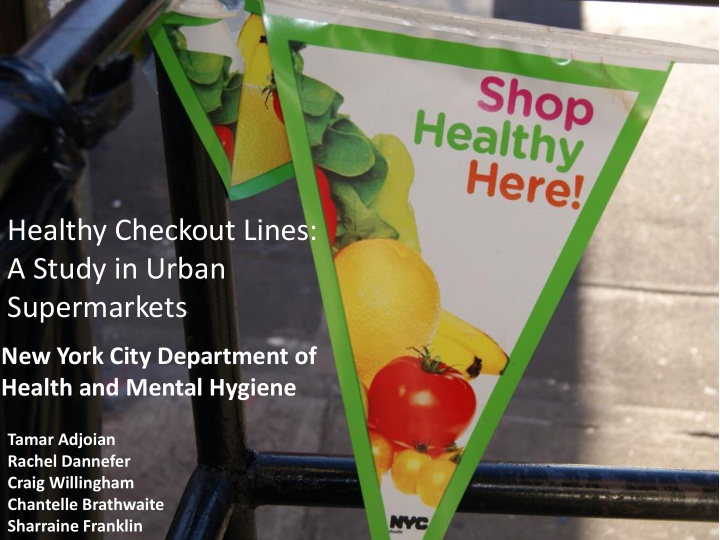



Healthy Checkout Lines: A Study in Urban Supermarkets New York City Department of Health and Mental Hygiene Tamar Adjoian Rachel Dannefer Craig Willingham Chantelle Brathwaite Sharraine Franklin
Shop Healthy NYC is a neighborhood-based approach that simultaneously addresses supply and demand Suppliers & Distributors Retailers Community Increased neighborhood access to healthy food
Healthy Checkout 2015: Objective To understand the impact of healthy checkouts on consumer behavior at three supermarkets in the South Bronx, New York City.
Healthy Checkout 2015: Study Design/Methods • Consumer purchasing behavior was observed in the summer of 2015 at three supermarkets in the South Bronx • Two checkout lines were selected per store; one converted to a “healthy checkout” and the other left as it was (“standard checkout”) • Signage was posted to identify healthy line
Healthy Checkout 2015: Study Design/Methods • Standard line remained unchanged, no signage posted • 2 weeks, 3-hour shifts, 3 days/week • Lines were switched mid-study to reduce line- selection bias
Healthy checkout display Standard checkout display
In-store materials were developed to help market Shop Healthy’s Checkout Line Pilot
Shop Healthy NYC Healthy Checkout Line Pilot
Healthy Checkout 2015: Study Design/Methods, cont’d • Data collection was conducted during busiest store hours, as identified by management: • 3 to 6 PM Tuesday - Friday, 12 to 3 PM on weekends • Two data collectors were positioned inside the store where they could observe consumer behavior at checkout lines • Data collectors recorded items purchased from observed lines during 18 observation periods
Healthy Checkout 2015: Results • A total of 2,131 shopping parties paid at the study lines during the study period: – 1,218 at the healthy checkout – 913 at the standard checkout • Only 4.0% of these parties (n = 85) bought anything from the checkout area of any line in the store – 3.8% of healthy checkout customers – 4.3% of standard customers
Healthy Checkout 2015: Results • Of customers who bought something from checkout, more than twice the proportion of customers using the healthy checkout bought healthy items as those using the standard checkout (56.5% vs 20.5%; P < .001) • In contrast, relatively fewer customers using the healthy checkout bought unhealthy items compared with those using the standard line (45.7% vs 74.4%; P = .008)
Healthy Checkout 2015: Results • For every 100 customers going through each line: – 4.7 items purchased from healthy totaling $8.73 – 6.4 items purchased from standard totaling $10.16 • Healthy items were purchased at a higher rate from the healthy line vs. the standard line
Healthy Checkout 2015: Results Most common purchases: Healthy: • fresh and packaged fruit (41%; n = 17) • chewing gum (27%; n = 11) • nuts and trail mix (24%; n = 10) Unhealthy: • candy (46%; n = 31) • Kool-Aid packets (18%; n = 12) • Slim Jim meat sticks (15%; n = 10)
Healthy Checkout 2015: Strengths • Observation allowed for understanding of unexpected consumer behavior/shopping patterns: – Moving items without purchase – Purchasing items at different lines from which they were taken – Deliberate/non-impulse buys • Ability to garner store owner support/buy-in through relationships and incentives
Healthy Checkout 2015: Limitations • Observational data is not the ideal methodology; future studies could benefit from technology such as coded UPCs or store-provided cash register sales data • Checkout lines at supermarkets in NYC, and more specifically the Bronx, are not necessarily typical/representative of supermarkets in other locales – Findings not generalizable; methods may need substantial adaptation • Approach may not apply in other settings with checkout items, such as office supply stores, clothing retail stores, etc.
Healthy Checkout 2015: Conclusions • A small percentage of customers (~4%) bought items from checkout area • Not necessarily generalizable to other locations or retail types • More robust studies on larger scale are warranted
Healthy Checkout 2015: Public Health Implications • The long-term sustainability of this type of intervention faces challenges. – Who is responsible for stocking checkouts? 1) Stores 2) Snack Vendors • Stores we worked with were all independently owned; it is unknown how implementation of such an intervention would fare at a corporate-owned chain
Thanks! Tamar Adjoian tadjoian@health.nyc.gov
Recommend
More recommend